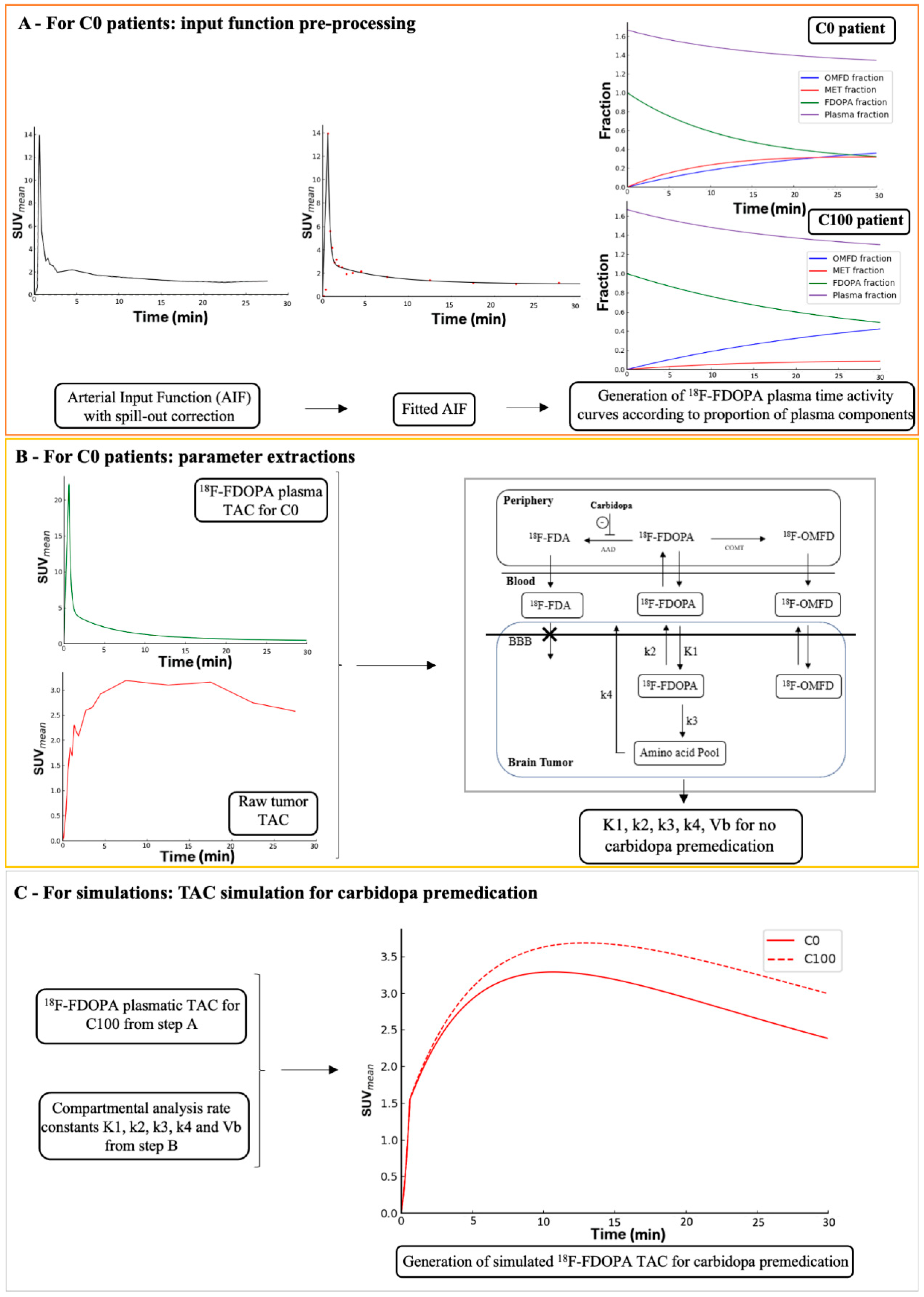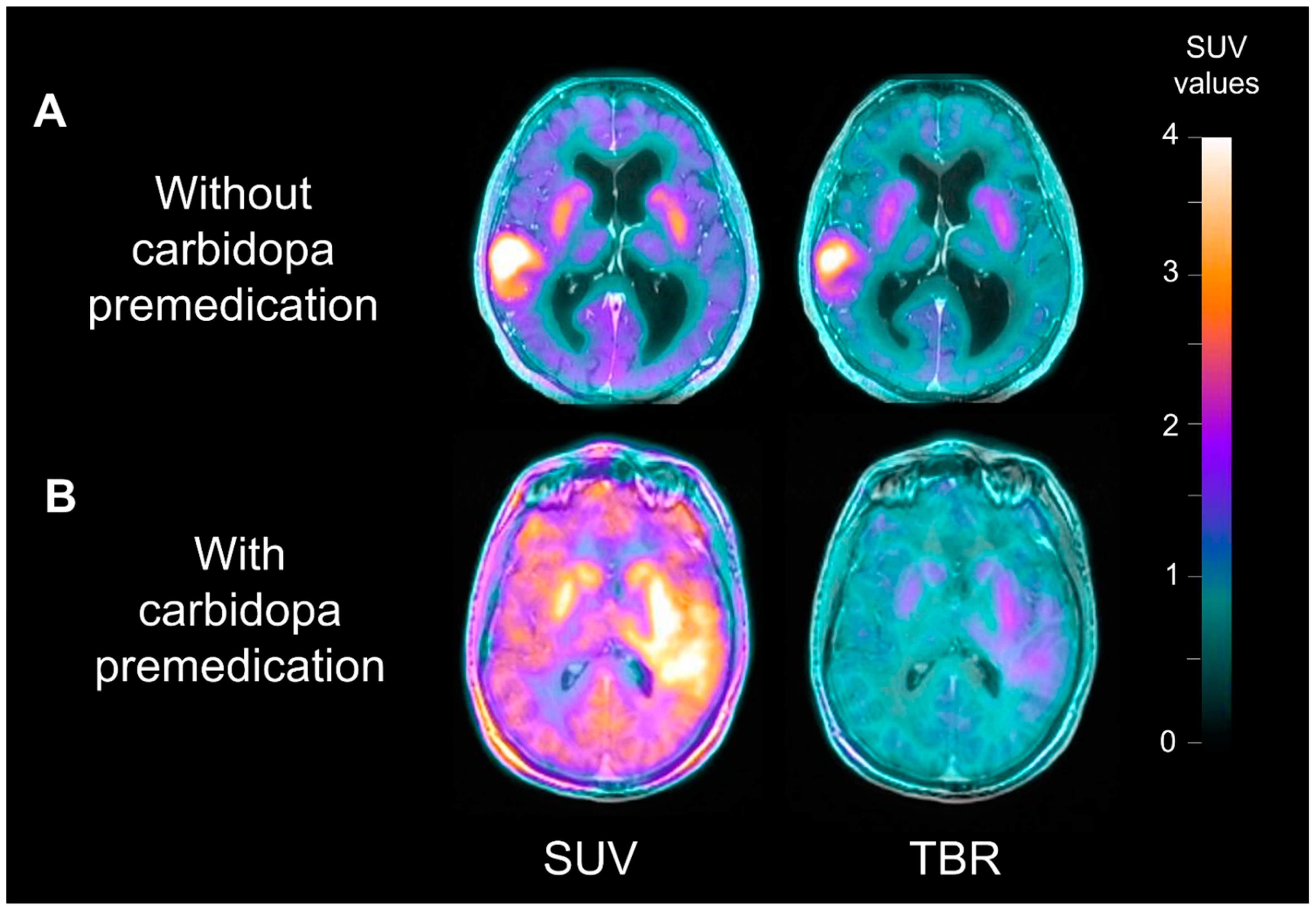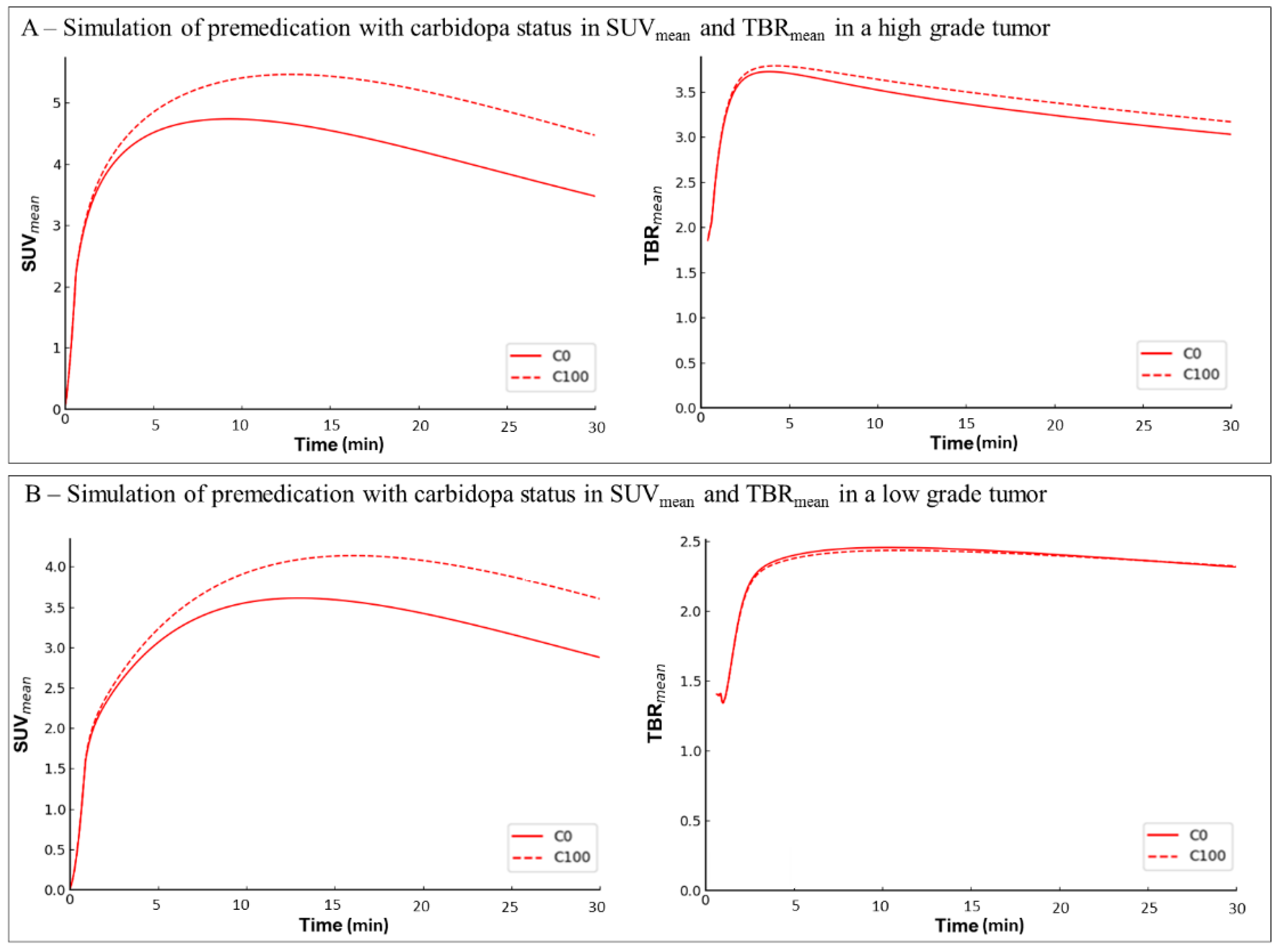Effects of Carbidopa Premedication on 18F-FDOPA PET Imaging of Glioma: A Multiparametric Analysis
Abstract
Simple Summary
Abstract
1. Introduction
2. Materials and Methods
2.1. Population and 18F-FDOPA PET Imaging
2.2. Image Analyses
2.2.1. Segmentation
2.2.2. Extraction of Parameters
2.3. Simulation
2.4. Statistical Analysis
3. Results
3.1. Patient Characteristics
3.2. Carbidopa Effects
4. Discussion
5. Conclusions
Supplementary Materials
Author Contributions
Funding
Institutional Review Board Statement
Informed Consent Statement
Data Availability Statement
Acknowledgments
Conflicts of Interest
References
- Heiss, W.-D.; Wienhard, K.; Wagner, R.; Lanfermann, H.; Thiel, A.; Herholtz, K.; Pietrzyk, U. F-Dopa as an Amino Acid Tracer to Detect Brain Tumors. J. Nucl. Med. 1996, 37, 1180–1182. [Google Scholar]
- Albert, N.L.; Weller, M.; Suchorska, B.; Galldiks, N.; Soffietti, R.; Kim, M.M.; la Fougère, C.; Pope, W.; Law, I.; Arbizu, J.; et al. Response Assessment in Neuro-Oncology Working Group and European Association for Neuro-Oncology Recommendations for the Clinical Use of PET Imaging in Gliomas. Neuro-oncology 2016, 18, 1199–1208. [Google Scholar] [CrossRef]
- Law, I.; Albert, N.L.; Arbizu, J.; Boellaard, R.; Drzezga, A.; Galldiks, N.; la Fougère, C. Joint EANM/EANO/RANO Practice Guidelines/SNMMI Procedure Standards for Imaging of Gliomas Using PET with Radiolabelled Amino Acids and [18F]FDG: Version 1.0. Eur. J. Nucl. Med. Mol. Imaging 2019, 46, 540–557. [Google Scholar] [CrossRef] [PubMed]
- Verger, A.; Kas, A.; Darcourt, J.; Chinot, O.; Taillandier, L.; Hoang Xuan, K.; Guedj, E. Joint SFMN/ANOCEF Focus on 18F-FDOPA PET Imaging in Glioma: Current Applications and Perspectives. Med. Nucl. 2020, 44, 164–171. [Google Scholar] [CrossRef]
- Kobayashi, K.; Ohnishi, A.; Promsuk, J.; Shimizu, S.; Kanai, Y.; Shiokawa, Y.; Nagane, M. Enhanced Tumor Growth Elicited by L-Type Amino Acid Transporter 1 in Human Malignant Glioma Cells. Neurosurgery 2008, 62, 493–504. [Google Scholar] [CrossRef]
- Papin-Michault, C.; Bonnetaud, C.; Dufour, M.; Almairac, F.; Coutts, M.; Patouraux, S.; Virolle, T.; Darcourt, J.; Burel-Vandenbos, F. Study of LAT1 Expression in Brain Metastases: Towards a Better Understanding of the Results of Positron Emission Tomography Using Amino Acid Tracers. PLoS ONE 2016, 11, e0157139. [Google Scholar] [CrossRef] [PubMed]
- Hoffman, J.M.; Meiega, W.; Hawk, T.; Grafton, S. The Effectsof CarbidopaAdministration on 6-[18F]Fluoro-L-DOPAKinetics in Positron Emission Tomography. J. Nucl. Med. 1992, 33, 1472–1477. [Google Scholar]
- Huang, S.; Yu, D.; Grafton, S.; Melega, W.P.; Hoffman, J.M. Kinetics and Modeling of L-6-EsP]Pluoro-DOPA in Human Positron Emission Tomographic Studies. J. Cereb. Blood Flow Metab. 1991, 11, 898–913. [Google Scholar] [CrossRef]
- Schiepers, C.; Chen, W.; Cloughesy, T.; Dahlbom, M.; Huang, S.-C. 18F-FDOPA Kinetics in Brain Tumors. J. Nucl. Med. 2007, 48, 1651–1661. [Google Scholar] [CrossRef]
- Morbelli, S.; Esposito, G.; Arbizu, J.; Barthel, H.; Boellaard, R.; Bohnen, N.I.; Brooks, D.J.; Darcourt, J.; Dickson, J.C.; Douglas, D.; et al. EANM Practice Guideline/SNMMI Procedure Standard for Dopaminergic Imaging in Parkinsonian Syndromes 1.0. Eur. J. Nucl. Med. Mol. Imaging 2020, 47, 1885–1912. [Google Scholar] [CrossRef]
- Louis, D.N.; Perry, A.; Reifenberger, G.; von Deimling, A.; Figarella-Branger, D.; Cavenee, W.K.; Ohgaki, H.; Wiestler, O.D.; Kleihues, P.; Ellison, D.W. The 2016 World Health Organization Classification of Tumors of the Central Nervous System: A Summary. Acta Neuropathol. 2016, 131, 803–820. [Google Scholar] [CrossRef] [PubMed]
- Zaragori, T.; Oster, J.; Roch, V.; Hossu, G.; Chawki, M.B.; Grignon, R.; Pouget, C.; Rech, F.; Blonski, M.; Taillandier, L.; et al. 18F-FDopa PET for the Non-Invasive Prediction of Glioma Molecular Parameters: A Radiomics Study. J. Nucl. Med 2021. [Google Scholar] [CrossRef]
- Nioche, C.; Orlhac, F.; Boughdad, S.; Reuze, S.; Goya-Outi, J.; Robert, C.; Pellot-Barakat, C.; Soussan, M. LIFEx: A Freeware for Radiomic Feature Calculation in Multimodality Imaging to Accelerate Advances in the Characterization of Tumor Heterogeneity. Cancer Res. 2018, 78, 4786–4789. [Google Scholar] [CrossRef]
- Unterrainer, M.; Vettermann, F.; Brendel, M.; Holzgreve, A.; Lifschitz, M.; Zähringer, M.; Suchorska, B.; Wenter, V.; Illigens, B.M.; Bartenstein, P.; et al. Towards Standardization of 18F-FET PET Imaging: Do We Need a Consistent Method of Background Activity Assessment? EJNMMI Res. 2017, 7, 48. [Google Scholar] [CrossRef]
- Cicone, F. The Mean Striatal 18F-DOPA Uptake Is Not a Reliable Cut-off Threshold for Biological Tumour Volume Definition of Glioma. Eur. J. Nucl. Med. Mol. Imaging 2018, 46, 1051–1053. [Google Scholar] [CrossRef] [PubMed]
- Zwanenburg, A.; Vallières, M.; Abdalah, M.A.; Andrearczyk, V.; Apte, A.; Ashrafinia, S.; Bakas, S.; Beukinga, R.J.; Boellaard, R.; Bogowicz, M.; et al. The image biomarker standardization initiative: Standardized quantitative radiomics for high-throughput image-based phenotyping. Radiology 2020, 295, 328–338. [Google Scholar] [CrossRef]
- Ye, H.; Wong, K.-P.; Wardak, M.; Dahlbom, M.; Kepe, V.; Barrio, J.R.; Nelson, L.D.; Small, G.W.; Huang, S.-C. Automated Movement Correction for Dynamic PET/CT Images: Evaluation with Phantom and Patient Data. PLoS ONE 2014, 9, 12. [Google Scholar] [CrossRef] [PubMed][Green Version]
- Ginet, M.; Zaragori, T.; Marie, P.-Y.; Roch, V.; Gauchotte, G.; Rech, F.; Blonski, M.; Lamiral, Z.; Taillandier, L.; Imbert, L.; et al. Integration of Dynamic Parameters in the Analysis of 18F-FDopa PET Imaging Improves the Prediction of Molecular Features of Gliomas. Eur. J. Nucl. Med. Mol. Imaging 2020, 47, 1381–1390. [Google Scholar] [CrossRef]
- Kratochwil, C.; Combs, S.E.; Leotta, K.; Afshar-Oromieh, A.; Rieken, S.; Debus, J.; Haberkorn, U.; Giesel, F.L. Intra-Individual Comparison of 18F-FET and 18F-DOPA in PET Imaging of Recurrent Brain Tumors. Neuro-Oncology 2014, 16, 434–440. [Google Scholar] [CrossRef]
- Martens, C.; Debeir, O.; Decaestecker, C.; Metens, T.; Lebrun, L.; Leurquin-Sterk, G.; Trotta, N.; Goldman, S.; Van Simaeys, G. Voxelwise Principal Component Analysis of Dynamic [S-Methyl-11C]Methionine PET Data in Glioma Patients. Cancers 2021, 13, 2342. [Google Scholar] [CrossRef] [PubMed]
- Zanotti-Fregonara, P.; Hirvonen, J.; Lyoo, C.H.; Zoghbi, S.S.; Rallis-Frutos, D.; Huestis, M.A.; Morse, C.; Pike, V.W.; Innis, R.B. Population-Based Input Function Modeling for [18F]FMPEP-D2, an Inverse Agonist Radioligand for Cannabinoid CB1 Receptors: Validation in Clinical Studies. PLoS ONE 2013, 8, e60231. [Google Scholar] [CrossRef]
- Wardak, M.; Schiepers, C.; Cloughesy, T.F.; Dahlbom, M.; Phelps, M.E.; Huang, S.-C. 18F-FLT and 18F-FDOPA PET Kinetics in Recurrent Brain Tumors. Eur. J. Nucl. Med. Mol. Imaging 2014, 41, 1199–1209. [Google Scholar] [CrossRef] [PubMed]
- Melega, W.P.; Hoffman, J.M.; Luxen, A.; Nissenson, C.H.; Phelps, M.E.; Barrio, J.R. The Effects of Carbidopa on the Metabolism of 6-[18F]Fluoro-L-Dopa in Rats, Monkeys and Humans. Life Sci. 1990, 47, 149–157. [Google Scholar] [CrossRef]
- Girard, A.; Le Reste, P.-J.; Metais, A.; Chaboub, N.; Devillers, A.; Saint-Jalmes, H.; Jeune, F.L.; Palard-Novello, X. Additive Value of Dynamic FDOPA PET/CT for Glioma Grading. Front. Med. 2021, 8, 705996. [Google Scholar] [CrossRef]
- Orlhac, F.; Soussan, M.; Chouahnia, K.; Martinod, E.; Buvat, I. 18F-FDG PET-Derived Textural Indices Reflect Tissue-Specific Uptake Pattern in Non-Small Cell Lung Cancer. PLoS ONE 2015, 10, e0145063. [Google Scholar] [CrossRef]
- Verger, A. Static and Dynamic 18F–FET PET for the Characterization of Gliomas Defined by IDH and 1p/19q Status. Eur. J. Nucl. Med. Mol. Imaging 2018, 45, 443–451. [Google Scholar] [CrossRef]
- Vettermann, F.; Suchorska, B.; Unterrainer, M.; Nelwan, D.; Forbrig, R.; Ruf, V.; Wenter, V.; Kreth, F.-W.; Herms, J.; Bartenstein, P.; et al. Non-Invasive Prediction of IDH-Wildtype Genotype in Gliomas Using Dynamic 18F-FET PET. Eur. J. Nucl. Med. Mol. Imaging 2019, 46, 2581–2589. [Google Scholar] [CrossRef]
- Lohmann, P.; Herzog, H.; Rota Kops, E.; Stoffels, G.; Judov, N.; Filss, C.; Galldiks, N.; Tellmann, L.; Weiss, C.; Sabel, M.; et al. Dual-Time-Point O-(2-[18F]Fluoroethyl)-L-Tyrosine PET for Grading of Cerebral Gliomas. Eur. Radiol. 2015, 25, 3017–3024. [Google Scholar] [CrossRef] [PubMed]
- Chen, W.; Silverman, D.H.S.; Delaloye, S.; Czernin, J.; Kamdar, N.; Pope, W.; Satyamurthy, N.; Schiepers, C.; Cloughesy, T. 18F-FDOPA PET Imaging of Brain Tumors: Comparison Study with 18F-FDG PET and Evaluation of Diagnostic Accuracy. J. Nucl. Med. 2006, 47, 904–911. [Google Scholar] [PubMed]
- Janvier, L.; Olivier, P.; Blonski, M.; Morel, O.; Vignaud, J.-M.; Karcher, G.; Taillandier, L.; Verger, A. Correlation of SUV-Derived Indices With Tumoral Aggressiveness of Gliomas in Static 18F-FDOPA PET: Use in Clinical Practice. Clin. Nucl. Med. 2015, 40, e429–e435. [Google Scholar] [CrossRef]
- Treglia, G.; Muoio, B.; Trevisi, G.; Mattoli, M.V.; Albano, D.; Bertagna, F.; Giovanella, L. Diagnostic Performance and Prognostic Value of PET/CT with Different Tracers for Brain Tumors: A Systematic Review of Published Meta-Analyses. IJMS 2019, 20, 4669. [Google Scholar] [CrossRef] [PubMed]



| Without Carbidopa | With Carbidopa | All Patients | p Value | |
|---|---|---|---|---|
| Premedication | Premedication | |||
| n | ||||
| Static | 36 | 18 | 54 | |
| Dynamic | 30 | 11 | 41 | |
| Age (years) median (range) | ||||
| Static | 45.2 (24.6; 82.6) | 37.4 (19.8; 72.7) | 44.0 (19.8; 82.6) | 0.21 |
| Dynamic | 46.7 (24.6; 73.7) | 33.3 (19.8; 72.8) | 45.2 (19.8; 73.7) | 0.13 |
| Female gender n (%) | ||||
| Static | 11 (31%) | 8 (44%) | 19 (35%) | 0.48 |
| Dynamic | 10 (33%) | 4 (36%) | 14 (34%) | 1 |
| Primary histopathological type n (%) | ||||
| Static | ||||
| IDH-mutant astrocytoma | ||||
| Anaplastic | 13 (36%) | 3 (17%) | 16 (30%) | |
| Non-anaplastic | 4 | 1 | 5 | |
| IDH-wildtype astrocytoma | 9 | 2 | 11 | |
| Anaplastic | 6 (17%) | 1 (6%) | 7 (13%) | |
| Non-anaplastic | 3 | 1 | 4 | 0.21 |
| IDH-mutant and 1p/19q co-deleted | 3 | 0 | 3 | |
| oligodendroglioma | 9 (25%) | 5 (28%) | 14 (26%) | |
| Anaplastic | ||||
| Non-anaplastic | 6 | 2 | 8 | |
| IDH-wildtype glioblastoma | 3 | 3 | 6 | |
| IDH-mutant glioblastoma | 6 (17%) | 6 (33%) | 12 (22%) | |
| 2 (6%) | 3 (17%) | 5 (9%) | ||
| Dynamic | ||||
| IDH-mutant astrocytoma | ||||
| Anaplastic | 13 (43%) | 2 (18%) | 15 (37%) | |
| Non-anaplastic | 4 | 1 | 5 | |
| IDH-wildtype astrocytoma | 9 | 1 | 10 | |
| Anaplastic | 4 (13%) | 0 (0%) | 4 (10%) | 0.17 |
| Non-anaplastic | 2 | 0 | 2 | |
| IDH-mutant and 1p/19q co-deleted | 2 | 0 | 2 | |
| oligodendroglioma | 7 (23%) | 4 (36%) | 11 (27%) | |
| Anaplastic | ||||
| Non-anaplastic | 5 | 2 | 7 | |
| IDH-wildtype glioblastoma | 2 | 2 | 4 | |
| IDH-mutant glioblastoma | 5 (17%) | 5 (45%) | 10 (24%) | |
| 1 (3%) | 0 (0%) | 1 (2%) |
| Parameter | Without Carbidopa Premedication | With Carbidopa Premedication | Correlation Coeffi-cient with SUVmean | p Value | Mean Relative Difference in % (Mean Absolute Difference) between Patients without and with Carbidopa Premedication | Median Relative Difference in % (Median Absolute Difference) between Patients without and with Carbidopa Premedication |
|---|---|---|---|---|---|---|
| Static features (in-house software) | ||||||
| SUVmean | 1.2 (1.02; 1.32) | 1.8 (1.53; 2.08) | 1 | <0.001 | 53.1% (+0.6) | 46.4% (+0.5) |
| SUVmax | 1.6 (1.45; 1.75) | 2.4 (2.03; 2.68) | 0.99 | <0.001 | 48% (+0.8) | 41.3% (+0.7) |
| SUVpeak | 1.4 (1.27; 1.57) | 2.1 (1.8; 2.36) | 0.99 | <0.001 | 50.2% (+0.7) | 44.2% (+0.6) |
| Dynamic features (in-house software) | ||||||
| TTP (min) | 12.5 (10.74; 13.64) | 18.5 (17.03; 18.96) | 0.61 | <0.001 | 48.5% (+6.1) | 46.2% (+5.6) |
| Slope (SUV/h) | −0.52 (−0.69; −0.39) | −0.06 (−0.18; 0.01) | 0.35 | <0.001 | 87.8% (+0.5) | 70% (+0.4) |
| Parameters | Without Carbidopa Premedication | With Carbidopa Premedication | Correlation Coefficient with SUVmean | p Value | Mean Relative Difference in % (Mean Absolute Difference) between Patients without and with Carbidopa Premedication | Median Relative Difference in % (Median Absolute Difference) between Patients without and with Carbidopa Premedication | TBR without Carbidopa Premedication | TBR with Carbidopa Premedication | TBR p Value |
|---|---|---|---|---|---|---|---|---|---|
| Static features (in-house software) | |||||||||
| SUVmean | 2.4 (1.94; 2.8) | 3.6 (3.14; 4.06) | 1 | <0.001 | 51.9% (+1.2) | 48% (+1.1) | 2.1 (1.78; 2.19) | 2.1 (1.87; 2.15) | 0.458 |
| SUVmax | 4.1 (2.6; 5.15) | 5.8 (4.08; 7.18) | 0.84 | 0.034 | 41.4% (+1.7) | 41.9% (+1.5) | 3.5 (2.18; 4.26) | 3.3 (2.44; 4.09) | 0.291 |
| SUVpeak | 3.4 (2.02; 4.21) | 4.9 (3.62; 6.16) | 0.86 | 0.034 | 44.1% (+1.5) | 51.2% (+1.5) | 2.9 (1.84; 3.49) | 2.8 (1.98; 3.31) | 0.335 |
| MTV (mL) | 20 (4.02; 29.07) | 20.1 (5.79; 24.77) | 0.38 | 0.608 | 0.9% (+0.2) | 31.2% (+3.7) | 20 (4.02; 29.07) | 20.1 (5.79; 24.77) | 0.608 |
| Dynamic features (in-house software) | 12.2 (2.83; 23.15) | 10.3 (2.48; 18) | 0.696 | ||||||
| TTP (mn) | 12.2 (7.37; 15.53) | 15.1 (9.43; 19.31) | 0.02 | 0.025 | 24.1% (+2.9) | 30.3% (+3.1) | −1.1 (−1.59; 0.41) | −1.7 (−1.9; −0.02) | 0.505 |
| Slope (SUV/h) | −2.71 (−3.14; −0.62) | −3.18 (−3.67; 0.14) | -0.27 | 0.962 | −17.6% (−0.5) | −93.8% (−1.1) | 2.1 (1.78; 2.19) | 2.1 (1.87; 2.15) | 0.458 |
| Parameters | Without Carbidopa Premedication | With Carbidopa Premedication | Mean Relative Difference in % (Mean Absolute Difference) between Patients without and with Carbidopa Premedication | Median Relative Difference in % (Median Absolute Difference) between Patients without and with Carbidopa Premedication | TBR without Carbidopa Premedication | TBR with Carbidopa Premedication | Mean Relative Difference in % (Mean Absolute Difference) between Patients without and with Carbidopa Premedication | Median Relative Difference in % (Median Absolute Difference) between Patients without and with Carbidopa Premedication |
|---|---|---|---|---|---|---|---|---|
| Dynamic features | ||||||||
| TTP (mn) | 10.7 (7.36; 12.75) | 13.0 (11.13; 15.68) | 25.8% (+2.9) | 21.4% (+2.3) | 4.6 (3.78; 9.27) | 4.7 (3.92; 9.70) | 2.9% (+0.3) | 2.2% (+0.1) |
| Slope (SUV/h) | −2.98 (−3.93; −1.31) | −2.21 (−3.32; −0.85) | 23.5% (+0.7) | 25.9% (+0.8) | −1.3 (−1.81; −0.07) | −1.3 (−1.67; −0.11) | −0.7% (−0.1) | 0% (0) |
Publisher’s Note: MDPI stays neutral with regard to jurisdictional claims in published maps and institutional affiliations. |
© 2021 by the authors. Licensee MDPI, Basel, Switzerland. This article is an open access article distributed under the terms and conditions of the Creative Commons Attribution (CC BY) license (https://creativecommons.org/licenses/by/4.0/).
Share and Cite
Bros, M.; Zaragori, T.; Rech, F.; Blonski, M.; Hossu, G.; Taillandier, L.; Marie, P.-Y.; Verger, A. Effects of Carbidopa Premedication on 18F-FDOPA PET Imaging of Glioma: A Multiparametric Analysis. Cancers 2021, 13, 5340. https://doi.org/10.3390/cancers13215340
Bros M, Zaragori T, Rech F, Blonski M, Hossu G, Taillandier L, Marie P-Y, Verger A. Effects of Carbidopa Premedication on 18F-FDOPA PET Imaging of Glioma: A Multiparametric Analysis. Cancers. 2021; 13(21):5340. https://doi.org/10.3390/cancers13215340
Chicago/Turabian StyleBros, Marie, Timothée Zaragori, Fabien Rech, Marie Blonski, Gabriela Hossu, Luc Taillandier, Pierre-Yves Marie, and Antoine Verger. 2021. "Effects of Carbidopa Premedication on 18F-FDOPA PET Imaging of Glioma: A Multiparametric Analysis" Cancers 13, no. 21: 5340. https://doi.org/10.3390/cancers13215340
APA StyleBros, M., Zaragori, T., Rech, F., Blonski, M., Hossu, G., Taillandier, L., Marie, P.-Y., & Verger, A. (2021). Effects of Carbidopa Premedication on 18F-FDOPA PET Imaging of Glioma: A Multiparametric Analysis. Cancers, 13(21), 5340. https://doi.org/10.3390/cancers13215340






